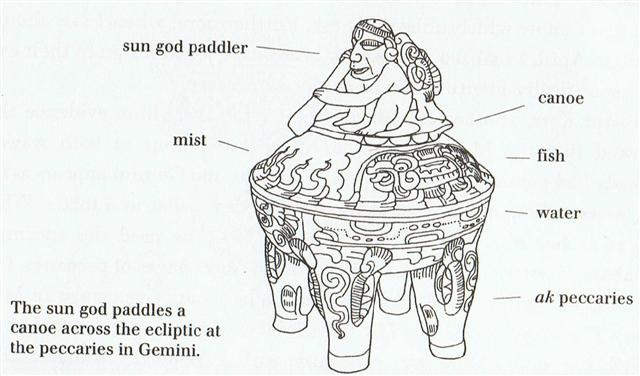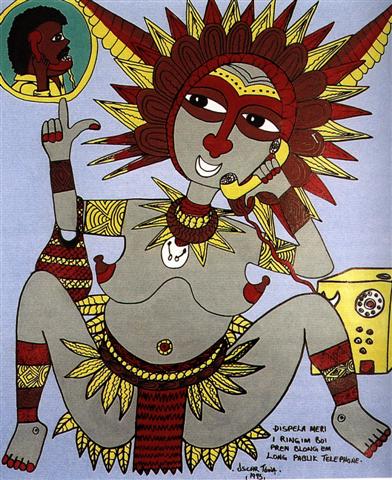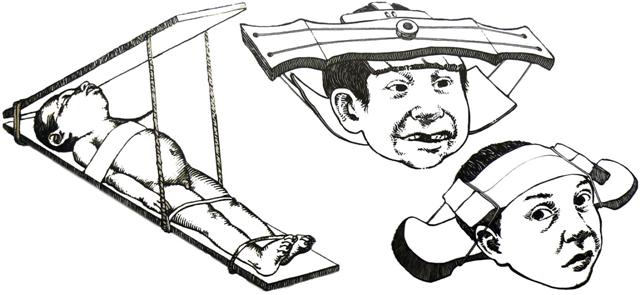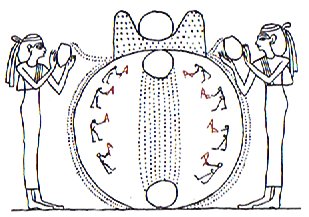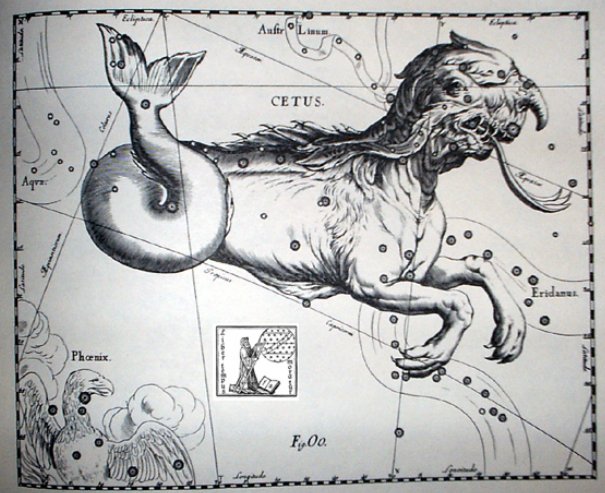Marduk had divided the night in half: ... A Scorpion-Man plays also another part in the cosmology of the Babylonians. The Scorpion-Man and his wife guard the gate leading to the Maśu mountain(s), and watch the sun at rising and setting. Their upper part reaches to the sky, and their irtu (breast?) to the lower regions (Epic of Gistubar 60,9). After Gistubar has traversed the Maśu Mountain, he reaches the sea. This sea lies to the east or south-east.
However obscure these conceptions may be, and however they may render a general idea impossible, one thing is clear, that the Scorpion-Men are to be imagined at the boundary between land and sea, upper and lower world, and in such a way that the upper or human portion belongs to the upper region, and the lower, the Scorpion body, to the lower. Hence the Scorpion-Man represents the boundary between light and darkness, between the firm land and the water region of the world. Marduk, the god of light, and vanquisher of Tiamat, i.e. the ocean, has for a symbol the Bull = Taurus, into which he entered in spring.
This leads almost necessarily to the supposition that both the Bull and the Scorpion were located in the heavens at a time when the sun had its vernal equinox in Taurus and its autumnal equinox in Scorpio, and that in their principal parts or most conspicuous star groups; hence probably in the vicinity of Alderbaran and Antares, or at an epoch when the principal parts of Taurus and Scorpio appeared before the sun at the equinoxes. [Cited from Jensen in his 'Kosmologie der Babylonier']
If my suggestion be admitted that the Babylonians dealt not with the daily fight but the yearly fight between light and darkness - that is, the antithesis between day and night was expanded into the antithesis between the summer and the winter halves of the year - then it is clear that at the vernal equinox Scorpio setting in the west would be watching the sunrise; at the autumnal equinox rising in the east, it would be watching the sunset; one part would be visible in the sky, the other would be below the horizon in the celestial waters. If this be so, all obscurity disappears, and we have merely a very beautiful statement of a fact, from which we learn that the time to which the fact applied was about 3000 B.C., if the sun were then near the Pleiades ... ... Marduk, die Frühsonne des Tages und des Jahres, wurde eben wegen dieses seines Charakters der Lichtbringer am Weltmorgen. Marduk, der die leblose, chaotische Nacht, die keine Gestaltungen erkennen lässt, besiegt, der den Winter mit seinem Wasserfluten, den Feind des Naturlebens, überwindet, wurde der Schöpfer des Lebens und der Bewegung, der Ordner des Regellosen, der Gestalter des Unförmlichen am Weltmorgen ... ... Die Sonne, die des Morgens das Weltmeer durchschreitet und besiegt und das Licht bringt, lässt aus dem Chaos der Nacht zuerst den Himmel, dann erst die Erde hervortreten, spaltet das gestaltlose Reich der Nacht in die zwei Hälften, den Himmel und die Erde ... If a new year was beginning not at spring equinox but already at the winter solstice, i.e. as if the Stag (Digging Stick) had robbed the night side of its fire so to say, then there should be a parallel season to be counted with either as ruled by the planets of the week or by the days in the light rays from the Sun.
The Sun was beginning to return after the winter solstice and this could motivate counting from there. The Sun would cross the equator on his way up at spring equinox and this could motivate counting from there.
According to the mammoth ivory notches it seems that we should add 49 and 39 in order to reach 88 (= 168 - 80) at the House of the Giant (Beth-el-Geuze). And this measure could represent 13 weeks (91 days) + 11 weeks (77 days) = 24 weeks (168 days) = 8 * 3 weeks (= 8 * 21 days):
Above (the ecliptic) was Aries (Land) and below was Cetus (Water), and the Back of the Head of Ku was ruled by Hamal:
The Back of the Head of Ku was at Gb7-28, with 'water' (sign of birth, hanau) below:
And above there was the occiput (teke) sign of the Stag (digging stick). From this bump in the head new horns would eventually develop.
... A sidelight falls upon the notions connected with the stag by Horapollo's statement concerning the Egyptian writing of 'A long space of time: A Stag's horns grow out each year. A picture of them means a long space of time.' Chairemon (hieroglyph no. 15, quoted by Tzetzes) made it shorter: 'eniautos: elaphos'. Louis Keimer, stressing the absence of stags in Egypt, pointed to the Oryx (Capra Nubiana) as the appropriate 'ersatz', whose head was, indeed, used for writing the word rnp = year, eventually in 'the Lord of the Year', a well-known title of Ptah. Rare as this modus of writing the word seems to have been - the Wörterbuch der Aegyptischen Sprache (eds. Erman and Grapow), vol. 2, pp. 429-33, does not even mention this variant - it is worth considering (as in every subject dealt with by Keimer), the more so as Chairemon continues his list by offering as number 16: 'eniautos: phoinix', i.e., a different span of time, the much-discussed 'Phoenix-period' (ca. 500 years) ...
Maybe Hamal surprisingly (mira) had taken over (robbed) a piece of Land from Ku.
The curious bend in the Eridanus river could then be accounted for. ... Strassmeier and Epping, in their Astronomishes aus Babylon, say that there its stars formed the third of the twenty-eight ecliptic constellations, - Arku-sha-rishu-ku, literally the Back of the Head of Ku, - which had been established along that great circle milleniums before our era; and Lenormant quotes, as an individual title from cuneiform inscriptions, Dil-kar, the Proclaimer of Dawn, that Jensen reads As-kar, and others Dil-gan, the Messenger of Light. George Smith inferred from the tablets that it might be the Star of the Flocks; while other Euphratean names have been Lu-lim, or Lu-nit, the Ram's Eye; and Si-mal or Si-mul, the Horn star, which came down even to late astrology as the Ram's Horn. It also was Anuv, and had its constellation's titles I-ku and I-ku-u, - by abbreviation Ku, - the Prince, or the Leading One, the Ram that led the heavenly flock, some of íts titles at a different date being applied to Capella of Auriga. Brown associates it with Aloros, the first of the ten mythical kings of Akkad anterior to the Deluge, the duration of whose reigns proportionately coincided with the distances apart of the ten chief ecliptic stars beginning with Hamal, and he deduces from this kingly title the Assyrian Ailuv, and hence the Hebrew Ayil; the other stars corresponding to the other mythical kings being Alcyone, Aldebaran, Pollux, Regulus, Spica, Antares, Algenib, Deneb Algedi, and Scheat ...
|
||||||||||||||||||||||||||||||||||||||||||||||||||||||||||||||||||||||||||||||||||||||||||||||||||||||||||||||||||||||||||||||||||||||||||||||||||||||||||||||||||||||||||||||||||||||||||||||||||||||||||||||||||||||||||||||||||||||||||||||||||||||||||||||||||||||||||||||||||||||





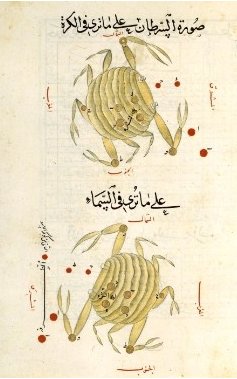
.jpg)
.jpg)
